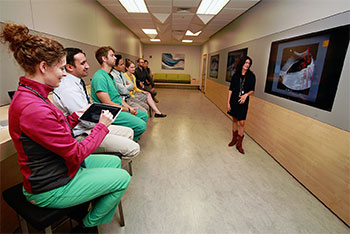Radiology Reinvents Classroom with BAR Lab
By Mark Couch
 (November 2016) The CU School of Medicine’s Department of Radiology has created a teaching space to replace lecture halls and improve student learning through technology.
(November 2016) The CU School of Medicine’s Department of Radiology has created a teaching space to replace lecture halls and improve student learning through technology.
The Beginning to Advanced Radiology Lab, which looks more like a Genius Bar at an Apple store than a typical 300-seat lecture hall on an academic campus, was completed in August 2015 and has attracted national attention for its innovative teaching methodologies.
“The methods that we use in the BAR Lab are predominately ‘flipped classroom,’” says Nicole Restauri, MD, assistant professor of radiology and BAR Lab director.
“Flipped-classroom methods imply that the students will complete a module or some kind of exercise outside of the classroom where they gain knowledge and they do this on their own time,” Restauri says, “and then they come into the BAR Lab and they apply it. We do problem-solving with an instructor facilitating the process in the lab.”
Medical students are presented real-life problems that correspond with issues they will face in clinical rounds. On iPad screens, students can interact and present cases that are displayed on large video monitors built into the wall of the lab.
“So what does that look like for our students?” asks Restauri during a presentation last summer to U.S. Sen. Cory Gardner when he visited the Anschutz Medical Campus. “During our surgery rotation, for example, students will complete a module on
Flashed onto the screen was an ultrasound of the right upper quadrant of a patient. Restauri and Gerald Dodd, III, MD, chair of the Department of Radiology, then explained to Gardner how to identify
Dodd calls it “just-in-time” learning because the cases are presented to correspond to the clerkships in which students are participating. Rather than sit for a month reviewing images disassociated from real-life cases, medical students now weave their experiences in internal medicine, orthopedics, surgery
As a result, students are improving their understanding of cases and their test scores.
“I think a key feature is that it allows the students to ask a question in here,” Restauri says. “One of our students commented that on the wards, there’s very little time to look at imaging and even less for someone to teach them. Here they have a dedicated instructor and they can improve by asking questions.”
One of the challenges of creating a new teaching space that is decked out with the latest equipment is that it isn’t cheap. With support from UCHealth, the new lab was equipped with Philips virtual simulation teaching PACS identical to the clinical application currently used throughout the University of Colorado Health System. The BAR Lab also utilizes iPads to deliver
Lecture halls may have served previous generations, but students now are seeking ways of learning that are in tune with their lives.
“Today’s learners are digital natives,” says Restauri. “They are millennials. They were born between the years 1982 to 2005 and they grew up with new technology, with iPads, with rapid access to information. They’re also very vocal about educational preferences and they typically shun didactic lectures.”
What they said was that they aren’t interested in sitting in a big crowd, learning alone, staring at a screen controlled by the lecturer standing in front of the room.
“They value an interactive educational experience and they embrace technology as a social tool and as an information resource,” says Restauri. “So as our learner population is changing, it prompts us to rethink not only how we educate our students, but the physical space in which we do so.”
The BAR Lab’s narrow classroom encourages team-based learning and its state-of-the-art equipment taps into the students’ experience of using technology to learn and get answers on their own.
“The BAR Lab was designed with both intentions,” says Restauri, “to facilitate an interactive learning environment and also to